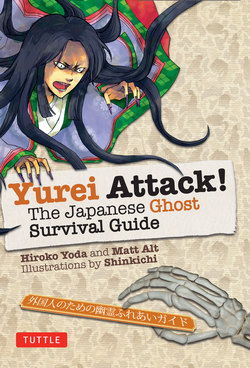Читать книгу Yurei Attack! - Hiroko Yoda - Страница 14
На сайте Литреса книга снята с продажи.
ОглавлениеSexy & Scary: 06
ORUI
Sexy & Scary: 06
ORUI
Name in Japanese: お累
Origin: A true story known as Kasane-ga-fuchi (“The Depths of Kasane”)
Gender: Female
Date of death: 164 7
Age of death: 32 (Estimated)
Cause of death: Murder by drowning
Distinctive features: Left side of face disfigured
Place of interment: Unknown
Location of haunting: Joso City (Ibaragi Prefecture)
Form of Attack: Haunting, causing of illness, possession
Existence: Based in part on a true story
Threat Level: High
Claim to Fame
This epic tale of murder and betrayal spanning sixty years and three generations is more “possession” than “haunting,” but it is all the more chilling for being based on an actual crime. The tale of Kasanega-fuchi is considered a bookend to that of the Yotsuya Kaidan (p.16), as Orui’s disfigurement is on the opposite side of the face as Oiwa’s.
In fact, spoken or staged performances of Orui’s story are traditionally never held on the same day as those of Yotsuya Kaidan. Although their origins are different (Orui’s being natural, as you will see, while Oiwa’s was caused by poison), the opposing disfigurements resemble each other so closely that bringing the two together creates a potentially dangerous symmetry for both performer and audience alike. Or so they say.
The Story
… begins in 1612, when a farmer by the name of Yoemon marries Sugi, a young widow with a little boy named Suké. Born with deformities from face to foot all down the left side of his body, Suké’s presence grated on Yoemon, who was never really “father material” to begin with. So one fine spring morning after the snowmelt, he kicked the young boy into a raging stream. Yoemon swore it was an accident, a lie that those around him chose to believe. (In fact, some speculate that Sugi actually collaborated with Yoemon out of fear he would leave her.)
But you can’t fool karma. When Yoemon and Sugi conceived their own child several years later, she was born with the exact same facial deformity and withered limbs as Suké. Although they named her Orui, villagers whispered of the evildoings that must have brought about such a strange fate. They began calling the child Kasane, an alternate reading of the same kanji-character, which means “double trouble.”
Yoemon and Sugi died while Orui was still quite young, leaving her the home and their meager savings. Yet her handicaps made it difficult to find a husband, and she lived alone for many years. One day, a drifter by the name of Yagoro wound up on her doorstep, virtually collapsing into her arms from the many maladies that beset even young men in an era before hospitals or real medicines. Orui dutifully nursed him back to health, and the grateful Yagoro married her in thanks for her generosity. It must have seemed a dream come true for Orui.
But the good times wouldn’t last. Yagoro quickly regretted his decision to marry and schemed with his mistress to get rid of Orui once and for all. Late in the summer of 1647, in a virtual replay of what had happened to her half-brother, Yagoro pushed Orui into a fast-moving river† to drown.
Yagoro married his mistress, but soon after tying the knot she took to her sickbed and died. He met and married again, with the same result. And again. And again. Eventually, his final wife died in childbirth, leaving him a daughter, Kiku.
The Attack
The problems began one December in 1672, when Kiku, now grown and married, fell ill and began speaking in a voice not her own. The voice claimed to be Orui, offering up a detailed account of how Yagoro had caused her death, and vowing to torment Kiku until given a proper funeral ceremony. A monk by the name of Yuten — a man we’ll be reading more about in chapter six (p.164) — happened to hear of the story and arrived to perform the requested rites. But no sooner had he drawn the spirit from her body than she fell ill again. Yuten probed Kiku for information, and discovered that she was inhabited by the restless soul of Suké as well. Connecting the dots between the two murders in a psychic version of a detective story, Yuten managed to guide the little boy’s spirit to the afterlife.
Of what happened to Yagoro, no record remains — but given his evil deeds, one can assume the remainder of his life — and presumably afterlife — were anything but pleasant.
Surviving an Encounter
If you’ve gotten yourself involved in a sordid tale of betrayal like this, chances are you’re beyond any help this book can give you. For the rest of us, the ghosts of Orui and Suké were content to make their own sad stories known and are no longer considered a threat. Rule of thumb for restless spirits: consult your local temple. And pray that an exorcist-monk as sharp as Yuten is on duty.
Trivia Notes
In 1957, director Nobuo Nakagawa filmed a version of Orui’s story called Kaidan Kasane-ga-fuchi (“The Horror of Kasane Swamp”). It is based, however, on an old rakugo (spoken word) dramatization that bears little resemblance to the original story. In this version of the tale, the ghost of a blind masseuse killed by a samurai lures his murderer to his death in Kasane swamp, seemingly avenging himself. But when the masseuse’s orphaned daughter Orui unwittingly falls in love with the samurai’s son years later, the cycle of death begins anew.
______________________
† Rivers are well-known haunts for spirits of various kinds. See also Ukai Kansaku (p. 85). Also see Kappa and the Azuki-Arai, in Yokai Attack! The Japanese Monster Survival Guide.
